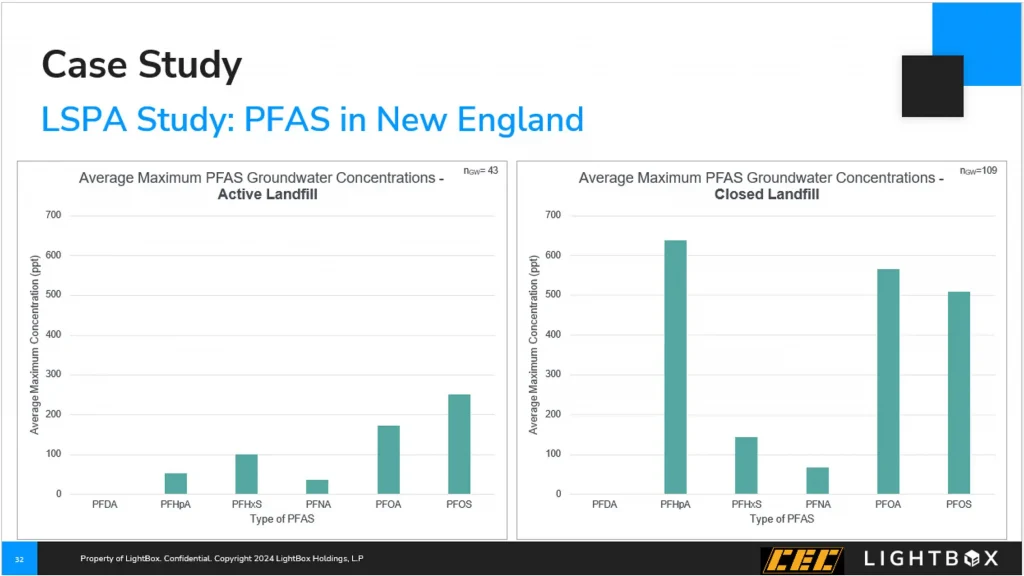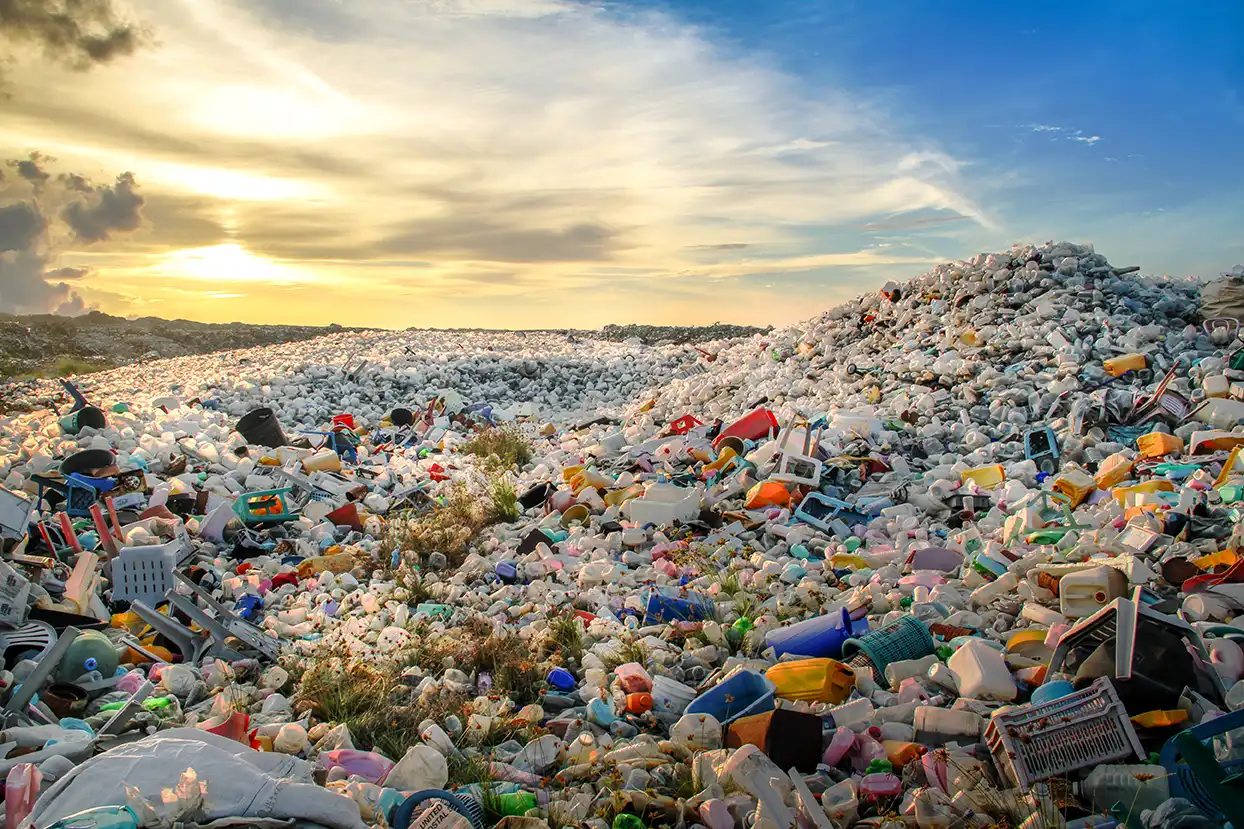During our latest webinar on January 24th, leading landfill expert Jonathan Kitchen joined LightBox for a candid look at the unique challenges of assessing PFAS at sites on or near landfill sites. The questions submitted by attendees were too numerous to cover during the live event so, as promised, we are sharing responses to technical questions below.
1. Regarding the studies completed on the leachate data, is it separated by type of landfill? Ex: MSW, Ash, C&D, etc… are the results different? Dramatic? The study looked at PFAS in groundwater concentrations rather than leachate. The database did not include landfill type but did include information on “closed” versus “open.” A comparison slide is included in the slide deck.
2. Since PFAS is now regulated by CERCLA / TSCA, why wouldn’t an upgradient PFAS source be considered a REC if there’s the potential for exposure to groundwater? EPA has not yet published a final rule listing PFAS or other mentioned Emerging Contaminants as Hazardous Substances, so they are currently considered outside the scope of E1527-21. Per the Standard Practice’s definition of a REC, a potential upgradient PFAS condition is not a REC unless PFAS are a Hazardous Substance per CERCLA. This link to our PFAS Due Diligence Scoping webinars provides additional information regarding REC or BER determinations and PFAS.
3. If a state has promulgated regulations for PFAS, i.e. MCLs for groundwater, why would PFAS not be a REC? Would that not be considered a release or potential release of a hazardous substance for that state? Per E1527-21, PFAS conditions are not considered RECs because they are not listed as Hazardous Substances per CERCLA, so they are currently E1527-21 “non-scope considerations.” Applicable state or other regulatory agency regulations should be considered by EPs when PFAS are included in a Phase I ESA scope. Some EPs choose to call a PFAS condition a Business Environmental Risk (BER) in these situations. We cover this topic thoroughly in our PFAS Due Diligence: ESA Scoping Strategies webinar on our PFAS Resource Center.
4. What is the LSPA? According to their website at LSPA.org, LSPA is a Massachusetts-based, “… non-profit association, founded in 1993, for Licensed Site Professionals (“LSPs”) and related practitioners.”
5. How about the usual case when we are dealing with nearby properties rather than the Solid Waste Landfill? Do we need to change the level of “due” diligence to protect clients? The panel discussion outlined key initial scope considerations and emphasized that EPs take a “case-by-case” approach to scoping decisions like file reviews, sampling, etc. What are the typical differences between PFAS from a pre-RCRA vs post-RCRA landfill? (i.e. different concentrations, different compounds, plume size, etc.) On average, there were differences in both the mix of compounds detected and the concentrations detected. These are shown on slide 13 of the presentation. Insufficient data was available to evaluate plume length at this time.

6. Is there a date after which PFAS is a concern? i.e., if a town dump was closed in 1973, was that before PFAS was in common use? While the PFAS family of chemicals have been around since the 1930s, use in commercial products that commonly end up in landfills began in the late 1940s and grew steadily with the emergence of products like Teflon and Scotchguard. So, a solid waste landfill that was active during that time would likely have some PFAS present.
7. I’m working on an ESA that has a nearby site (industry: Fabricated Metal Product Manufacturing) that Lightbox listed as an EPA “PFAS ECHO” site. First time seeing the PFAS database listing. No PFAS info was found on the ECHO website for the listed facility. The PFAS Analytical Tools didn’t list the facility at all. When using the EPA PFAS databases and the PFAS Analytical Tools it is important to keep in mind the source and nature of the records at this juncture. This is from EPA’s website, “The datasets that feed EPA’s Enforcement and Compliance History Online (ECHO) integrates records from a range of federal regulatory programs (e.g., Clean Water Act, Clean Air Act, and Resource Conservation and Recovery Act) at the facility level. ECHO records are restricted to potential PFAS-handling industry sectors identified from literature reviews and field investigations by several EPA offices…Note that inclusion of a facility in the ECHO PFAS Industry Sectors dataset does not indicate that PFAS are actually being manufactured, processed, used, or released by the facility.” Regarding your inability to locate your site on the PFAS Analytical Tools webpage, we have found that the interface and geolocation of sites in the Tools may not be ideal for doing a single site search. Still, the Tools can be a helpful supplement to our Radius Map report in some circumstances.
8. What is considered to be part of the “Laundry/Uniform” category? Dry cleaners? Others? It is believed that PFAS from treated textiles are released during laundering and dry cleaning. PFAS has also been observed at “wet” cleaning operations such as large-scale uniform and commercial laundering facilities. A 2019 study was conducted by the Florida Department of Environmental Protection (DEP) of 15 dry cleaners that were slated for state-funded cleanups. Extensive testing for PFAS of the wastewater and other wastes during routine operations confirmed that the source of PFAS was most likely treated clothing or stains that were released during cleaning. Here is a link to that study with more information.
9. What is the data source for the slide with the polar bear? For more information on the map and data, see, “Detection of Poly- and Perfluoroalkyl Substances (PFASs) in U.S. Drinking Water Linked to Industrial Sites, Military Fire Training Areas, and Wastewater Treatment Plants” Xindi C. Hu et al, Environmental Science and Technology Letters, October 2016.
10. When looking at historical analytical data that have not run PFAS-specific analysis, are there constituents that would be indications of a possibility of PFAS potential existence near a solid waste landfill? At landfills, the presence of any elevated concentration of leachate indicator parameters (numerous analytes that could include TDS, chloride, sodium, certain VOCs, etc.) at landfills would be a clue that leachate may be present and, as such, elevated PFAS could also be present.
11. Would you expect a commercial laundry to be a significant source of PFAS in its wastewater? (From laundering fabrics that have stain-resisting chemicals.) The aforementioned Florida DEP study of Dry Cleaners found that 10 of the 15 sites sampled exceeded Groundwater Cleanup Target Levels (GCTLs) for PFOA and PFOS of 70 nanograms per liter (ng/l) for the sum of PFOA and PFOS concentrations. Data from the CEC study would suggest “wet” laundries would also be of concern.
12. Can you share a link to the study that CEC did? LSPA April 2022 Membership Meeting: PFAS: Is It Really Everywhere? And Whose Is It?
FOR MORE INFORMATION
For a link to the recording of our past events in this PFAS series, visit the LightBox PFAS Resource Center.
